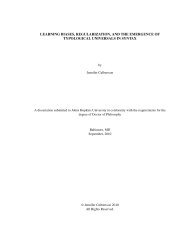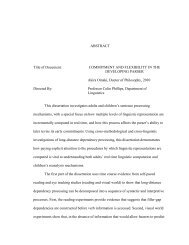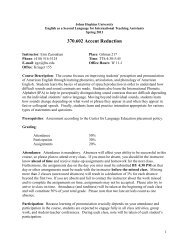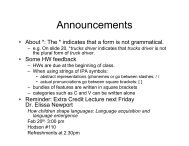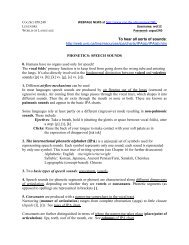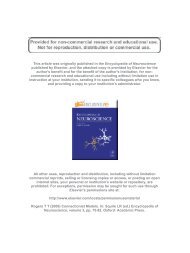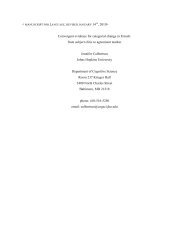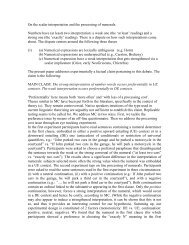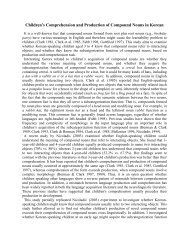Newell & Simon 1963
Newell & Simon 1963
Newell & Simon 1963
Create successful ePaper yourself
Turn your PDF publications into a flip-book with our unique Google optimized e-Paper software.
U.S. copyright law<br />
(title 17 of U.S. code)<br />
governs the reproduction<br />
and redistribution of<br />
copyrighted material.
First AAAI Press Edition, 1995<br />
Copyright O 1995, American Association for Artificial Intelligence<br />
445 Burgess Drive<br />
Menlo Park, CA 94025<br />
All rights reserved. No part of this book may be reproduced in any<br />
form by any electronic or mechanical means (including photocopy-<br />
ing, recording, or information storage and retrieval) without permis-<br />
sion in writing from the publisher.<br />
COMPUTERS<br />
and THOUGHT<br />
edited by<br />
EDWARD A. FEIGENBAUM<br />
&, JULIAN FELDMAN<br />
AAAI Press I The MIT Press<br />
MENLO PARK CAMBRIDGE LONDON
~~ program.<br />
GPS, A PROGRAM THAT<br />
SIMULATES HUMAN THOUGHT<br />
by Allen <strong>Newell</strong> & H. A. <strong>Simon</strong><br />
This article is concerned with the psychology of human thinking. It sets<br />
forth a theory to explain how some humans try to solve some simple<br />
formal problems. The research from which the theory emerged is intimately<br />
related to the field of information processing and the construction of intel-<br />
ligent automata, and the theory is expressed in the form of a computer<br />
The rapid technical advances in the art of program-ming digital<br />
computers to do sophisticated tasks have made such a theory feasible.<br />
It is often argued that a careful line must be drawn between the attempt<br />
to accomplish with machines the same tasks that humans perform, and<br />
the attempt to simulate the processes humans actually use to accomplish<br />
these tasks. The program discussed in the report, GPS (General Problem<br />
Solver), - maximally confuses the two approaches-with-mutual-benefit.<br />
GPS has previously been described as an attempt to build a problem-<br />
solving program (<strong>Newell</strong>, Shaw, and <strong>Simon</strong>, 1959u, 19604 , and in our<br />
own research it remains a major vehicle for exploring the area of artificial<br />
intelligence. Simultaneously, variants of GPS provide simulations of human<br />
behavior (<strong>Newell</strong> and <strong>Simon</strong>, 196 la). It is this latter aspect-the use of<br />
GPS as a theory of human problem-solving-that we want to focus on<br />
exclusively here, with special attention to the relation between the theory<br />
and the data.<br />
As a context for the discussion that is to follow, let us make some brief<br />
comments on some history of psychology. At the beginning of this century<br />
the prevailing thesis in psychology was Associationism. It was an atomistic<br />
doctrine, which postulated a theory of hard little elements, either sensa-<br />
tions Òr ideas, that became hooked or associated together without modifica-<br />
279
280 SIMULATION OP, COGNITIVE PROCESSES<br />
tion. It was a mechanistic doctrine, with simple fixed laws of contiguity in<br />
time and space to account for the formation of new associations. Those<br />
were its assumptions. Behavior proceeded by the stream of associations:<br />
Each association produced its successors, and acquired new attachments<br />
with the sensations arriving from the environment.<br />
In the first decade of the century a reaction developed to this doctrine<br />
through the work of the Wurzburg school. Rejecting the notion of a<br />
completely self-determining stream of associations, it introduced the task<br />
(Aufgabe) as a necessary factor in describing the process of thinking. The<br />
task gave direction to thought.. A noteworthy innovation of the Wurzburg<br />
school was the use of systematic introspection to shed light on the thinking<br />
process and the contents of consciousness. The result was a blend of<br />
mechanics and phenomenalism, which gave rise in turn to two divergent<br />
antitheses, Behaviorism and the Gestalt movement.<br />
The behavioristic reaction insisted that introspection was a highly un-<br />
stable, subjective procedure, whose ’futility was amply demonstrated in the<br />
controversy on imageless thought. Behaviorism reformulated the task of<br />
psychology as one of explaining the response of organisms as a function<br />
of the stimuli impinging upon them and measuring both objectively. How-<br />
ever, Behaviorism accepted, and indeed reinforced, the mechanistic as-<br />
sumption that the connections between &nulus and response were<br />
formed and maintained as simple, determinate functions of the en-<br />
vironment.<br />
The Gestalt reaction took an opposite turn. It rejected the mechanistic<br />
nature of the associationist doctrine but maintained the value of phe-<br />
nomenal observation. In many ways it continued the Wurzburg school’s<br />
insistence that thinking was more than association-thinking has direction<br />
given to it by the task or by the set of the subject. Gestalt psychology<br />
elaborated this doctrine in genuinely new ways in terms of holistic prin-<br />
ciples of organization.<br />
Today psychology lives in a state of relatively stable tension between<br />
the poles of Behaviorism and Gestalt psychology. All of us have internalized<br />
the major lessons of both: We treat skeptically the subjective elements in<br />
our experiments and agree that all notions must eventually be made opera-<br />
tional by means of behavioral measures. We also recognize that a human<br />
being is a tremendously complex, organized system, and that the simple<br />
schemes of modern behavioristic psychology seem hardly to reflect this<br />
at all.<br />
An Experimental Situation<br />
In this context, then, consider the following situation. A human subject,<br />
a student in engineering in an American college, sits in front of a black-<br />
board on which are written the following expressions:<br />
This is a problem in elementary symbolic logic, but the student does not<br />
know it. He does know that he has twelve rules for manipulating expres-<br />
sions containing letters connected by “dots” ( o ), “wedges” (V), “horse-<br />
shoes” ( 3 ), and “tildes” (- ), which stand respectively for “and,” “or,”<br />
“implies,” and “not.” These rules, given in Fig. 1, show that expressions<br />
of certain forms (at the tails of the arrows) can be transformed into ex-<br />
pressions of somewhat different form (at the heads of the arrows).<br />
(Double arrows indicate transformations can take place in either direc-<br />
Objects are formed by building up expressions from letters (P, Q, R, . . .I an$<br />
connectives (dot); V (wedge), 3 (horseshoe), and -(tilde). Examples are<br />
P, -Qr P V Q, -(R 3 S) -P; --P is equivalent to P throughout.<br />
Twelve rules exist for transforming expressions (where A,.B, and C may be<br />
any expressions or subexpressions 1:<br />
RI. A - B+B A R 8. A B-+A Applies to main<br />
AYB-BVA A B --+ B expression only.<br />
R2. A3B-+- B 3 - A R 9. A-+A V X Applies to main<br />
expression only.<br />
R3. A A++A<br />
A V A M A<br />
R 10. ;j+A . B A and B are two<br />
main expressions.<br />
R4. A (B C)+--+(A B) C RII. A A and A 3 B are two<br />
A V (B V C)+-+(A V B) V C<br />
R5. A V Bt--,-(-A* -B) R12. A ZB<br />
B =)C]<br />
R6. A B W - A V B<br />
R7. A*(BVC)W(A-B)V(A*C)<br />
AV(B-C)t-,(AVB)-(A.VC)<br />
Example, showing subject’s entire course of solution on problem:<br />
1. (R3-P)*(-RDQ) 1 -(-Q*PI<br />
2.<br />
3.<br />
4.<br />
5.<br />
6.<br />
7.<br />
8.<br />
9.<br />
10.<br />
11.<br />
12.<br />
13.<br />
14.<br />
AXBandBXC<br />
are two main ex-<br />
pressions.<br />
Rule 6 applied to left and right of 1.<br />
Rule 6 applied to left OF 1.<br />
Rule 8 applied to 1.<br />
Rule 6 applied to 4.<br />
Rule 8 applied to 1.<br />
Rule 6 applied to 6.<br />
Rule IO applied to 5. and 7.<br />
Rule 2 applied to 4.<br />
Rule 2 applied to 6.<br />
Rule I2 applied to 6. and 9.<br />
Rule 6 applied to 11.<br />
Rule 5 applied to 12.<br />
Rule I applied to 13. QED.<br />
Figure 1. The task of symbolic logic.
282 SIMULATION OF COGNITIVE PROCESSES<br />
Well, looking at the left hand side of the equation, first we want to eliminate<br />
one of the sides by using rule 8. It appears too complicated to work with first.<br />
Now - no, - no, I can’t do that because I will be eliminating either the Q or<br />
the P in that total expression. I won’t do that at first. Now I’m looking for a<br />
way to get rid of the horseshoe inside the two brackets that appear on the left<br />
and right sides of the equation. And I don’t see it. Yeh, if you apply rule 6 to<br />
both sides of the equation, from there I’m going to see if I can apply rule 7.<br />
Experimenter writes: 2. (- R V N P ( R V QI<br />
I can almost apply rule 7, but one R needs a tilde. So I’ll have to look for<br />
another rule. I’m going to see if I can change that R to a tilde R. As a<br />
matter of fact, I should have used rule 6 on only the leFt hand side of the<br />
equation. So use rule 6, but only on the left hand side.<br />
Experimenter writes: 3. ( - R V - P 1 ( -R =I QI<br />
NOW IlII apply rule 7 as it is expressed. Both - excuse me, excuse me, it<br />
can’t be done because of the horseshoe. So - now I’m looking - scanning the<br />
rules here for a second, and seeing if I can change the R to a -R in the second<br />
equation, but I don’t see any way of doing ít. (Sigh.) I’m just sort of lost for a<br />
second.<br />
Figure 2. Subject’s protocol on first part of problem.<br />
tion.) The subject has practiced applying the rules, but he has previously<br />
done only one other problem like this. The experimenter has instructed<br />
him that his problem is to obtain the expression in the upper right corner<br />
from the expression in the upper left corner using the twelve rules. At any<br />
time the subject can request the experimenter to apply one of the rules<br />
to an expression that is already on the blackboard. If the transformation<br />
is legal, the- experimenter writes down the new expression in the left-hand<br />
column, with the name of the rule in the right-hand column beside it. The<br />
subject’s actual course of solution is shown beneath the rules in Fig. 1.<br />
The subject was also asked to talk aloud as he worked; his comments<br />
were recorded and then transcribed into a “protocol,”--Le., a verbatim<br />
record of all that he or the experimenter said during the experiment. The<br />
initial section of this subject’s protocol is reproduced in Fig. 2.<br />
The Problem of Explanation<br />
It is now proposed that the protocol of Fig. 2 constitutes data about<br />
human behavior that are to be explained by a psychological theory. But<br />
what are we to make of this? Are we back to the introspections of the<br />
Wurzburgers? And how are we to extract information from the behavior<br />
of a single subject when we have not defined the operational measures we<br />
wish to consider?<br />
There is little difficulty in viewing this situation through behavioristic<br />
eyes. The verbal utterances of the subject are as much behavior as would<br />
GPS, A PROGRAM THAT SIMULATES HUMAN THOUGHT 283<br />
bB his arm movements or galvanic skin responses. The subject was not<br />
introspecting; he was simply emitting a continuous stream of verbal be-<br />
havior while. solving the problem. Our task is to find a model of the human<br />
problem-solver that explains the salient features of this stream of behavior.<br />
This stream contains not only the subject’s extemporaneous comments,<br />
but also his commands to the experimenter, which determine whether he<br />
solves the problem or not.<br />
Although this way of viewing the behavior answers the questions stated<br />
above, it raises some of its own. How is one to deal with such variable<br />
behavior? Isn’t language behavior considered among the most complex<br />
human behavior? How does one make reliable inferences from a single<br />
sample of data on a single subject?<br />
The answers to these questions rest upon the recent, striking ad-<br />
vances that have been made in computers, computer programming<br />
and artificial intelligence. We have learned that a computer is a general<br />
manipulator of symbols-not just a manipulator of numbers. Basically, a<br />
computer is a transformer of patterns. By suitable devices, most notably<br />
its addressing logic, these patterns can be given all the essential charac-<br />
teristics of linguistic symbols. They can be copied and formed into expres-<br />
sions. We have known this abstractly since Turing’s work in the mid-<br />
thirties, but it is only recently that computers have become powerful<br />
enough to let us actually explore the capabilities of complex symbol<br />
manipulating systems.<br />
For our purpose here, the most important branch of these explorations<br />
is the attempt to construct programs that solve tasks requiring intelligence.<br />
Considerable success has already been attained (Gelernter, 19593; Kilburn<br />
et al., 1959; Minsky, 1961a; <strong>Newell</strong>, Shaw, and <strong>Simon</strong>, 1957a, 19583;<br />
Samuel, 1959a; Tonge, 1960). These accomplishments form a body of<br />
ideas and techniques that allow a new approach to the building of psycho-<br />
logical theories. (Much of the work on artificial intelligence, especially<br />
our own, has been partly motivated by concern for psychology; hence,<br />
the resulting rapprochement is not entirely coincidental.)<br />
We may then conceive of an intelligent program that manipulates sym-<br />
bols in the same way that our subject does-by taking as inputs the sym-<br />
bolic logic expressions, and producing as ouputs a sequence of rule appli-<br />
cations that coincides with the subject’s. If we observed this program in<br />
operation, it would be considering various rules and evaluating various<br />
expressions, the same sorts of things we see expressed in the protocol of<br />
the subject. If the fit of such a program were close enough to the overt<br />
behavior of our human subject-Le., to the protocol-then it would con-<br />
stitute a good theory of the subject’s problem-solving.<br />
Conceptually the matter is perfectly straightforward. A program pre-<br />
scribes in abstract terms (expressed in some programming language) how
284 SIMULATION OP COGNITIVE PROCESSES<br />
a set of symbols in a memory is to be transformed through time, It is<br />
completely analogous to a set of difference equations that prescribes the<br />
transformation of a set of numbers through time. Given enough informa-<br />
tion about an individual, a program could be written that would describe<br />
the symbolic behavior of that individual. Each individual would be de-<br />
scribed by a different program, and those aspects of human problem-<br />
solving that are not idiosyncratic would emerge as the common structure<br />
and content of the programs of many individuals.<br />
But is it possible to write programs that do the kinds of manipulation<br />
that humans do? Given a specific protocol, such as the one of Fig. 2, is it<br />
possible to induct the program of the subject? How well does a program<br />
fit the data? The remainder of the report will be devoted to answering<br />
some of these questions by means of the single example already presented.<br />
We will consider only how GPS behaves on the first part of the problem,<br />
and we will compare it in detail with the subject’s behavior as revealed<br />
in the protocol. This will shed’considerable light on how far we can con-<br />
sider programs as theories of human problem-solving.<br />
The GPS Program<br />
We will only briefly recapitulate the GP program, since our description<br />
will add little to what has already been .S\ published (<strong>Newell</strong>, Shaw, and<br />
<strong>Simon</strong>, 1959a, 1960a). GPS deals with a task environment consisting of<br />
objects which can be transformed by various operators; it detects differences<br />
between objects; and it organizes the information about the task<br />
environment into goals. Each goal is a collection of information that defines<br />
what constitutes goal attainment, makes available the various kinds<br />
of information relevant to attaining the goal, and relates the information<br />
to other goals. There are three types of goals:<br />
Transform object A into object B,<br />
Reduce difference D between object A and object B,<br />
Apply operator Q to object A.<br />
For the task of symbolic logic, the objects are logic expressions; the op-<br />
erators are the twelve rules (actually the specific variants of them) ; and<br />
the differences are expressions like “change connective” or “add a term.”<br />
Thus the objects and operators are given by the task; whereas the differ-<br />
ences are something GPS brings to the problem. They represent the ways<br />
of relating operators to their respective effects upon objects.<br />
Basically, the GBS program is a way of achieving a goal by setting up<br />
suIq.rals whose attainment leads to the attainment of the initial goal. GPS<br />
has various schemes, called methods, for doing this. Three crucial meth-<br />
ods are presented in Fig 3: one method associated with each goal type.<br />
GPS, A PROGRAM THAT SIMULATES HUMAN THOUGHT 285<br />
Thus, to transform an object A into an object B, the objects are &st<br />
matched-put into correspondence and compared element by element.<br />
If the match reveals a difference, D, between the two objects, then a sub-<br />
goal is set up to reduce this difference. If this subgoal is attained, a new<br />
object, A’, is produced which (hopefully) no longer has the difference<br />
D when compared with object B. Then a new subgoal is created to trans-<br />
form A‘ into B. If the transformation succeeds, the entire goal has been<br />
attained in two steps : from A‘ to A’ and from A’ to B.<br />
If the goal is to reduce the difference between two objects, the first step<br />
is to find an operator that is relevant to this difference. Relevance here<br />
Goal: Transform obiect A into object B<br />
I l r I<br />
Match A to B<br />
to find<br />
difference D<br />
D<br />
Subgoal:<br />
Reduce D<br />
A’<br />
Subgool :<br />
Transform A’into B<br />
success<br />
L- Success<br />
Jnone ifait ifail<br />
Success Foi I Fa¡ I<br />
Goal: Reduce difference D between.object A and object B<br />
, r I<br />
Search for operator Q 1 Q 4 Test if feasible 1 yes 4 Apply Subgoal Q : to A I relevant to reducing D (preliminary)<br />
oroducina A‘<br />
I l 1 I 1 ’ I<br />
none no fail<br />
A<br />
Fail<br />
A’ rSucceos<br />
Goal: Apply operator Q to object A<br />
Match condition ’<br />
of Q to A to<br />
find difference D<br />
1 - I<br />
D<br />
’ Subgoal:<br />
Reduce D<br />
Produce result Success<br />
Far the logic task of the text :<br />
A’<br />
*<br />
Fa¡ I Fail<br />
Subgoal: . A” +success<br />
Apply Q to A‘<br />
Feasibility test (preliminary) :<br />
Is the mean connective the same 7 (e.g., A*B -..r B fails against PvQ)<br />
Is the operator too big ? (e.g., (AvB)*(AvCl - Av (B.C) fails against P-Q)<br />
Is the operatortoo easy? (e.g., A-A-A applies to anything)<br />
Are the side conditions satisfied ? (e.g., R8 applies only to main expressions)<br />
Table of connections<br />
Add terms<br />
Delete terms<br />
Change connective<br />
Change sign<br />
Change lower sign<br />
Change grouping<br />
Change position<br />
x means some variant of the ruleis relevant. GPS will pick the oppropriate variant.<br />
Figure 3. Methods for GPS.
286 SIMULATION OF COGNITIVE PROCESSES GPS, A PROGRAM THAT SIMULATES HUMAN THOUGHT 287<br />
means that the operator' affects objects with respect to the difference.<br />
Operationally, relevance can be determined by applying the matching proc-<br />
ess already used to the input and output forms of the operators, due<br />
account being taken of variables. The results can be summarized in a<br />
table of connections, as shown in Fig. 3, which lists for each difference<br />
the operators that are relevant to it. This table also lists the differences<br />
that GPS recognizes. [This set is somewhat different from the one given<br />
in <strong>Newell</strong>, Shaw, and <strong>Simon</strong> ( 19594 ; it corresponds to the program we<br />
will deal with in this report.] If a relevant operator, Q, is found, it is sub-<br />
jected to a preliminary test of feasibility, one version of which is given in<br />
Fig. 3. If the operator passes this test, a subgoal is set up to apply the<br />
operator to the object. If the operator is successfully applied, a new object,<br />
A', is produced which is a modification of the original one in the direction<br />
of reducing the difference. (Of course, other modifications may also have<br />
occurred which nullify the usefulness of the new object.)<br />
If the goal is to apply an operator, the first step is to see if the conditions<br />
of the operator are satisfied. The preliminary test above by no means guar-<br />
antees this. If the conditions are satisfied, then the output, A, can be gen-<br />
erated. If the conditions are not satisfied, then some difference, D, has<br />
been detected and a subgoal is created to reduce this difference, just as<br />
with the transform goal. Similarly, if a modifìed object, A', is obtained, a<br />
new subgoal is formed to try to apply the operator to this new object.<br />
These methods form a recursive system that generates a tree of sub-<br />
goals in attempting to attain a given goal. For every new difficulty that is<br />
encountered a new subgoal is created to overcome this difficulty. GPS has<br />
a number of tests it applies to keep the expansion of this goal tree from<br />
proceeding in unprofitable directions. The most important of these is a<br />
test which is applied to new subgoals for reducing differences. GPS con-<br />
tains an ordering of the differences, so that some differences are considered<br />
easier than others. This ordering is given by the table of connections in<br />
Fig. 3, which lists the most difficult differences first. GPS will not try a<br />
suegoal if it is harder than one of its supergoals. It will also not try a<br />
goal if it follows an easier goal. That is, GPS insists on working on the<br />
hard differences first and expects to find easier ones as it goes along. The<br />
other tests that GPS applies involve external limits (e.g., a limit on the<br />
total depth of a goal tree it will tolerate) and whether new objects or<br />
goals are identical to ones already generated.<br />
GPS on the Problem<br />
The description we have just given is adequate to verify the reasonable-<br />
ness, ahlough not the detail, of a trace of GPS's behavior on a specific<br />
problem. (In particular we have not described how the two-line rules, R10<br />
through R12, are handled, since they do not enter into the protocol we<br />
are examining.) In Fig. 4, we give the trace on the initial part of problem<br />
Dl. Indentation is used to indicate the relation of a subgoal to a goal.<br />
Although the methods are not shown, they can clearly be inferred from the<br />
goals that occur.<br />
The initial problem is to transform L1 into LO. Matching L1 to LO<br />
reveals that there are Rs in L1 and no Rs in LO. This difference leads to<br />
the formulation of a reduce goal, which for readability has been given<br />
its functional name, Delete. The attempt to reach this goal leads to a<br />
search for rules which fìnds rule 8. Since there are two forms of rule 8,<br />
both of which are admissible, GPS chooses the first. (Variants of rules are<br />
not indicated, but can be inferred easily from the trace.) Since rule 8 is<br />
LO -(-Q*P)<br />
L1 (R=-P)*(-R 34)<br />
GOAL 1 TRANSFORM L1 INTO LO<br />
GOAL 2 DELETE R FROM L1<br />
GOAL 3 APPLY R8 TO L1<br />
PRODUCES L2 RX-P<br />
GOAL 4 TRANSFORM L2 INTO LO<br />
GOAL 5 ADD Q TO L2<br />
REJECT<br />
GOAL 2<br />
GOAL 6 APPLY R8 TO L1<br />
PRODUCES L3 -RDQ<br />
GOAL 7 TRANSFORM L3 INTO LO<br />
GOAL 8 ADD P TO L3<br />
REJECT<br />
G3AL 2<br />
GOAL 9 APPLY R7 TO L1<br />
GOAL 10 CHANGE CONNECTIVE TOV IN LEFT L1<br />
GOAL 11 APPLY Rb TO LEFT L1<br />
PRODUCES.L4 (-RV -P)* (-R2Q)<br />
GOAL 12 APPLY R7 TO L4<br />
GOAL 13 CHANGE CONNECTIVE TO V IN RIGHT L4<br />
GOAL 14 APPLY R6 TO RIGHT L4<br />
PRODUCES L5 (-RV -P) * (R VQ)<br />
GOAL 15 APPLY R7 TO L5<br />
GOAL 16 CHANGE SIGN OF LEFT RIGHT ~5<br />
GOAL 17 APPLY R6 TO RIGHT L5<br />
PRODUCES L6 (-RV -P)*(-RXQ)<br />
GOAL 18 APPLY R7 TO L6<br />
GOAL 19 CHANGE CONNECTIVE TO V<br />
IN RIGHT L6<br />
REJECT<br />
GOAL 16<br />
NOTHING MORE<br />
GOAL 13<br />
NOTHING MORE<br />
GOAL 10<br />
NOTHING MORE<br />
Figure 4. Trace of GPS on first part of problem.
288 SIMULATION OF COGNITIVE PROCESSES<br />
applicable, a new object L2, is produced. Following the method for trans-<br />
form goals, at the next step a new goal has been generated: to transform<br />
L2 into LO. This in turn leads to another reduce goal: to restore a Q to<br />
L2. But this goal is rejected by the evaluation, since adding a term is more<br />
difficult than deleting a term. GPS then returns to goal 2 and seeks an-<br />
other rule which will delete terms. This time it finds the other form of<br />
rule 8 and goes through a similar excursion, ending with the rejection of<br />
goal 8.<br />
Returning again to goal 2 to find another rule .for deleting terms, GPS<br />
obtains rule 7. It selects the variant (A V B) (A V C) + A V (B C),<br />
since only this one both decreases terms and has a dot as its main con-<br />
nective. Rule 7 is not immediately applicable; GPS first discovers that<br />
there is a difference of connective in the left subexpression, and then that<br />
there is one in the right subexpression. In both cases it fìnds and applies<br />
rule 6 to change the connective from horseshoe to wedge, obtaining suc-<br />
cessively L4 and L5. But the new expression reveals a difference in sign,<br />
which leads again to rule 6-that is, to the same rule as before, but per-<br />
ceived as accomplishing ä different function. Rule 6 produces L6, which<br />
happens to be identical with L4 although GPS does not notice the identity<br />
here. This leads, in goal 19, to the difference in connective being rede-<br />
tected; whereupon the goal is finally rejected as representing no progress<br />
over goal 13. Further attempts to find alternative ways to change signs or<br />
connectives fail to yield anything. This ends the episode.<br />
Comparison of the GPS Trace with the Protocol<br />
We now have a highly detailed trace of what GPS did. What can we<br />
find in the subject’s protocol that either confirms or refutes the assertion<br />
that this program is a detailed model of the symbol manipulations the<br />
subject is carrying out? What sort of correspondence can we expect? The<br />
program does not provide us with an English language output that can be<br />
put into one-one correspondence with the words of the subject. We have<br />
not even given GPS a goal to “do the task and talk at the same time,’’<br />
wliich would be a necessary reformulation if we were to attempt a cor-<br />
respondence in such detail. On the other hand, the trace, backed up by<br />
our knowledge of how it was generated, does provide a complete record<br />
of all the task content that was considered by GPS, and the order in<br />
which it was taken up. Hence, we should expect to find every feature of<br />
the protocol that concerns the task mirrored in an essential way in the<br />
program trace. The converse is not true, since many things concerning<br />
the task surely occurred without the subject’s commenting on them (or<br />
even being aware of them). Thus, our test of correspondence is one-sided<br />
but exacting.<br />
GPS, A PROGRAM THAT SIMULATES HUMAN THOUGHT 289<br />
Let us start with the first sentence of the subject’s protocol (Fig. 2) :<br />
Well, looking at the left-hand side of the equation, first we want to<br />
eliminate one of the sides by using rule 8.<br />
We see here a desire to decrease L1 or eliminate something from it, and<br />
the selection of rule 8 as the means to do this. This stands in direct<br />
correspondence with goals 1,2, and 3 of the trace.<br />
Let us skip to the third and fourth sentences:<br />
Now-no,-no, I cm’t do that because I will be eliminating either the<br />
Q or the P in that total expression. I won’t do that at first.<br />
We see here a direct expression of the covert application of rule 8, the<br />
subsequent comparison of the resulting expression with LO, and the re-<br />
jection of this course of action because it deletes a letter that is required<br />
in the final expression. It would be hard to find a set of words that ex-<br />
pressed these ideas more clearly. Conversely, if the mechanism of the<br />
program (or something essentially similar to it) were not operating, it<br />
would be hard to explain why the subject uttered the remarks that he did.<br />
One discrepancy is quite clear. The subject handled both forms of rule<br />
8 together, at least as far as his comment is concerned. GPS, on the other<br />
‘nand, took a separate cycle of consideration for each form. Possibly the<br />
Tubject followed the program covertly and simply reported the two results<br />
cogether. However, we would feel that the fit was better if GPS bad -m-<br />
ceeded something as follows :<br />
GOAL 2 DELETE. R FROM L1<br />
GOAL 3 APPLY R8 TO L1<br />
PRODUCES L2 R a -P OR -RI4<br />
GOAL 4 TRANSFORM L2 INTO LO<br />
GOAL 5 ADD Q TO RI-P OR ADD P TÓ -RDQ<br />
REJECT<br />
We will consider further evidence on this point later.<br />
Let us return to the second sentence, which we skipped over:<br />
It appears too complicated to work with first.<br />
Nothing in the program is in simple correspondence with this statement,<br />
though it is easy to imagine some possible explanations. For example,<br />
this could merely be an expression of the matching-of the fact that L1<br />
is such a big expression that the subject cannot absorb all its detail. There<br />
is not enough data locally to determine what part of the trace should<br />
correspond to this statement, so the sentence must stand as an unexplained<br />
element of the subject’s behavior.
290 SIMULATION OF COGNITIVE PROCESSES GPS, A PROGRAM THAT’ SIMULATES HUMAN THOUGHT 29-1<br />
Now let us consider the next few sentences of the protocol:<br />
Now I’m looking for a way to get rid of the horseshoe inside the two<br />
brackets that appear on the left and right side of the equation. And I<br />
don’t see it. Yeh, if you apply rule 6 to both sides of the equation, from<br />
there I’m going to see if I can apply rule 7.<br />
This is in direct correspondence with goals 9 through 14 of the trace.<br />
The comment at the end makes it clear that applying rule 7 is the main<br />
concern and that changing connectives is required in order to accomplish<br />
this. Further, the protocol shows clearly that rule 6 was selected as the<br />
means. All three rule selections provide some confirmation that a prelimi-<br />
nary test for feasibility was made by the subject-as by GPS-in the<br />
reduce goal method. If there was not selection on the main connective,<br />
why wasn’t rule 5 selected instead of rule 6? Or why wasn’t the<br />
(A B) V (A C) + A (B V C) form of rule 7 selected?<br />
However, there is a discrepancy between trace and protocol, for the<br />
subject handles both applications of rule 6 simultaneously, (and appar-<br />
ently ’was also handling the two differences simultaneously); whereas<br />
GPS handles them sequentially. This is similar to the discrepancy noted<br />
earlier in handling rule 8. Since we now have two examples of parallel<br />
processing, it is likely that there is a real difference on this score. Again,<br />
we would feel better if GPS proceeded somewhat as follows :<br />
GOAL 9 APPLY R7 TO L1<br />
GOAL 10 CHANGE CONNECTIVE TOV IN LEFT L’1 AND kitiHT L1<br />
GOAL 11 APPLY R6 TO LEFT L1 AND RIGHT L1<br />
PRODUCES L5 (-R V -P) - (R VQ)<br />
A common feature of both these discrepancies is that forming the com-<br />
pound expressions does not complicate the methods in any essential way.<br />
Thus, in the case involving rule 8, the two results stem from the same<br />
input form, and require only the single match. In the case involving rule<br />
7, a single search was made for a. rule and the rule applied to both parts<br />
simultaneously, just as if only a single unit was involved.<br />
There are two aspects in which the protocol provides information that<br />
tlie program is not equipped to explain. First, the subject handled the<br />
application of rule 8 covertly but commanded the experimenter to make<br />
the applications of rule 6 on the board. The version of GPS used here<br />
did not make any distinction between internal and external actions. To<br />
this extent it fails to be an adequate model. The overt-covert distinction<br />
has consequences that run throughout a problem, since expressions on the<br />
blackboard have very different memory characteristics from expressions<br />
generated only in the head. Second, this version of GPS does not simu-<br />
late the search process sufficiently well to provide a correspondent to<br />
“And I don’t see it. Yeh, . . .”, This requires providing a facsimile of<br />
the rule sheet, and distinguishing search on the sheet from searches is<br />
the memory.<br />
The next few sentences read:<br />
I can almost qply rule 7, but one R needs a tilde. So I’ll have to look<br />
for mother rule. I’m going to see if I can change that R to a tilde R.<br />
Again the trace and the protocol agree on the difference that is seen.<br />
They also agree that this difference was not attended to earlier, even<br />
though it was present. Some fìne structure of the data also agrees with<br />
the trace. The right-hand R is taken as having the difference (R to - R)<br />
rather than the left-hand one, although either is possible. This preference<br />
arises in the program (and presumably in the subject) from the language<br />
habit of working from left to right. It is not without consequences, how-<br />
ever, since it determines whether the subject goes to work on the left side<br />
or the right side of the expression; hence, it can affect the entire course of<br />
events for quite a while. Similarly, in the rule 8 episode the subject appar-<br />
ently worked from left to right and from top to bottom in order to arrive<br />
at “Q or P” rather than “P or Q.” This may seem like concern with ex-<br />
cessively detailed features of the protocol, yet those details support the<br />
contention that what is going on inside the human system is quite akin to<br />
the symbol manipulations going on )inside GPS.<br />
The next portion of the protocol is :<br />
As a matter of fact, I should have used rule 6 on only the left-hand<br />
side of the equation. So use 6, but only on the left-hand side.<br />
-, ‘<br />
Here we have a strong departure from the GPS trace, although, curiously<br />
enough., the trace and the protocol end up at the same spot,<br />
(- R V - P) (W R 3 Q). Both the subject and GPS found rule 6 as<br />
the appropriate one to change signs. At this point GPS simply applied the<br />
rule to the current expression; whereas the subject went back and cor-<br />
rected the previous application. Nothing exists in the program that cor-<br />
responds to this. The most direct explanation is that the application o€<br />
rule 6 in the inverse direction is perceived by the subject as undoing the<br />
previous application of rule 6. After following out this line of reasoning,<br />
he then takes the simpler (and less foolish-appearing) alternative, which<br />
is to correct the original action.<br />
The final segment of the protocol reads :<br />
Now I’ll apply rule 7 as it is expressed. Both-excuse me, excuse me,<br />
it can’t be done because of the horseshoe. So-now I’m looking-<br />
scanning the rules here fur a second, and seeing if I can change the<br />
R to -R in the second equation, but I don’t see any way of doing it.<br />
(Sigh). I’m just sort of lost for a second.
292 SIMULATION OF COGMTIVE PROCESSES GPS, A PROGRAM THAT SIMULATES HUMAN THOUGHT 293<br />
The trace and the protocol are again in good agreement. This is one of<br />
the few self-correcting errors we have encountered. The protocol records<br />
the futile search for additional operators to affect the differences of sign<br />
and connective, always with negative results. The final comment of mild<br />
despair can be interpreted as reflecting the impact of several successive<br />
failures .<br />
Summary of the Fit of the Trace to the Protocol<br />
Let us take stock of the agreements and disagreements between the<br />
trace and the protocol. The program provides a complete explanation of<br />
the subject’s task behavior with five exceptions of varying degrees of<br />
seriousness.<br />
There are two aspects in which GPS is unprepared to simulate the sub-<br />
ject’s behavior: in distinguishing between the internal and external worlds,<br />
and in an adequate representation of the spaces in which the search for<br />
rules takes place. Both of these are generalized deficiencies that can be<br />
remedied. It will remain to be seen how well GPS can then explain data<br />
about these aspects of behavior.<br />
The subject handles certain sets of items in parallel by using compound<br />
expressions; whereas GPS handles all items one at a time. In the example<br />
examined here, no striking differences in problem solving occur as a result,<br />
but larger discrepancies could arise under other conditions. It is fairly<br />
clear how GPS could be extended to incorporate this feature.<br />
There are two cases in which nothing corresponds in the program to<br />
some clear task-oriented behavior in the protocol. One of these, the early<br />
comment about “complication,” seems to be mostly a case of insufficient<br />
information. The program is making numerous comparisons and evalua-<br />
tions which could give rise to comments of the type in question. Thus this<br />
error does not seem too serious. The other case, involving the “should<br />
have . . .” passage, does seem serious. It clearly implies a mechanism<br />
(maybe a whole set of them) that is not in GPS. Adding the mechanism<br />
required to handle this one passage could significantly increase the total<br />
capabilities of the program. For example, there might be no reason’able<br />
way to accomplish this except to provide GPS with a little continuous<br />
hindsight about its past actions.<br />
An additional general caution must be suggested. The quantity of data<br />
is not large considering the size and complexity of the program. This<br />
implies that there are many degrees of freedom available to fit the pro-<br />
gram to the data. More important, we have no good way to assess how<br />
many relevant degrees of freedom a program possesses, and thus to know<br />
how easy it is to fit alternative programs. All we do know is that numer-<br />
ous minor modifications could certainly be made, but that no one has<br />
proposed any major alternative theories that provide anything like a<br />
comparably detailed explanation of human problem-solving data.<br />
It would help if we knew something of how idiosyncratic the program<br />
was. We have discussed it here only in relation to one sample of data for<br />
one subject. We know enough about subjects on logic problems to assert<br />
that the same mechanisms show up repeatedly, but we cannot discuss<br />
these data here in detail. In addition, several recent investigations more<br />
generally support the concept of i.nformation processing theories of human<br />
thinking (Bruner et al., 1956; Feigenbaum, 1961a; Feldman, 1961a;<br />
Hovland and Hunt, 1960; Miller et al., 1960).<br />
Conclusion<br />
We have been concerned in this report with showing that the techniques<br />
that have emerged for Constructing sophisticated problem-solving pro-<br />
grams also provide us with new, strong tools for constructing theories of<br />
human thinking. They allow us to merge the rigor and objectivity asso-<br />
ciated with Behavioris-m with the wealth of data and complex behavior<br />
associated with the Gestalt movement. To this end their key feature is not<br />
that they provide a general framework for understanding problem-solving<br />
behavior (although they do that, -too) , but that they finally reveal with<br />
great clarity that the free behavior of a reasonably intelligent human can<br />
be understood as the product of a complex but finite and determinate set<br />
of laws. Although we know this only for small fragments of behavior, the<br />
depth of the explanation is striking.



